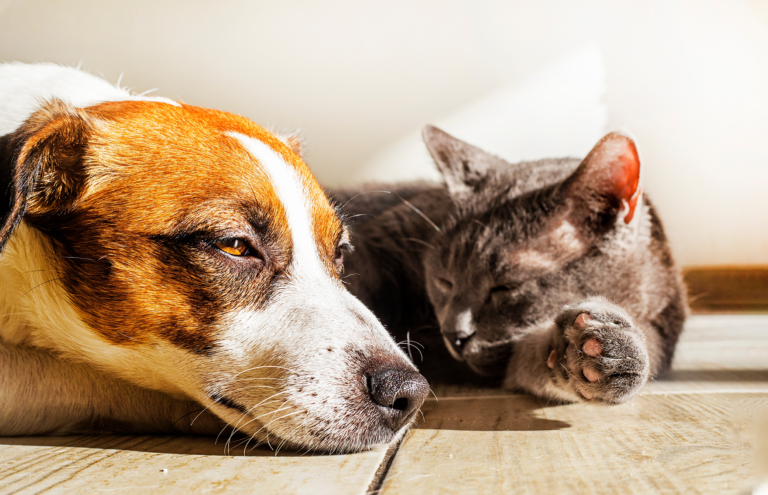Pet Diabetes: Insights, Strategies, and Nutritional Approaches
Summary
Diabetes is a relatively common disease in dogs and cats. Nutritional management strategies aimed at mitigating disease progression can significantly improve health and well-being of pets.
Pet diabetes is one of the most frequently diagnosed endocrine issues in cats and dogs. It is influenced by a variety of factors including environmental exposures and genetics.1-3 Dogs tend to develop a version that is similar to type 1 diabetes in humans, whereas cats tend to develop a condition that more closely resembles type 2 diabetes.1,2 Similar to humans, healthy nutrient intake can improve overall health and quality of life in pets with diabetes.
Understanding Pet Diabetes
Canine diabetes
Diabetes in dogs is typically characterized by pancreatic beta cell destruction and absolute insulin deficiency, similar to type 1 diabetes in humans.2 Beta cell destruction may be due to immune processes that target pancreatic islets, although environmental factors and the gut immune system may also play a role.2 Some dog breeds are predisposed for diabetes, possibly due to susceptibility in immune system genes.3 At the cellular level, diabetic dogs display a reduction in the number and size of pancreatic islets as well as a decrease in beta cells within the islets and abnormal beta cell morphology.1 Diabetes cannot be reversed in dogs. It often requires exogenous insulin and dramatic lifestyle changes to help control blood glucose levels.1
Pancreatitis is responsible for diabetes in over a quarter of dogs and may play a role in beta cell autoimmunity in genetically susceptible dogs.2,3 Obesity contributes to both insulin resistance and pancreatitis, but it is not considered an independent risk factor for diabetes in dogs.2 In fact, obese dogs with signs of insulin resistance can compensate via increased insulin secretion for many years and oftentimes it does not develop into diabetes.1-3
Canine diabetes can also lead to the development of secondary endocrine issues including hypercortisolism.3 Glucocorticoids released in excess during the stress response can cause insulin resistance and affect pancreatic beta cell function due to their cytotoxic effects.3
Feline diabetes
Diabetes in cats resembles type 2 diabetes in humans, with about 80 percent of diabetic cats suffering from a type 2-like version including insulin resistance.1,2 Primary causes of feline diabetes include islet amyloidosis, obesity, pancreatitis, and other hormonal diseases.1,2 Some cases can arise due to diseases that decrease beta cell number or cause insulin resistance such as pancreatic adenocarcinoma and pancreatitis.1,2 Cats with diabetes tend to exhibit impaired insulin action in liver, muscle, and adipose tissue as well as beta cell failure.1 Environmental and genetic factors can play a role in diabetes development, especially in Burmese cats.1,2
Obesity is a major contributor to the development of diabetes in cats, along with sex (males have increased risk), physical inactivity, indoor confinement, and aging.1-3 Obese cats are four times more likely to develop diabetes compared to those with an optimal body weight, and even short-term weight gain can induce insulin resistance.1,4,5 Weight loss can correct insulin resistance induced by weight gain and also lead to remission of diabetes in some cases.1,4 Obesity likely contributes to diabetes development through several pathways including:1
- Lower expression of the insulin-sensitive glucose transporter GLUT4 in muscle and fat tissues
- Lower expression of insulin signaling genes in liver and skeletal muscle
- Decreased adiponectin alongside leptin resistance
- Increased TNF-α and other pro-inflammatory cytokines
Another major pathway that affects diabetes development in cats is the accumulation of islet amyloid polypeptide (IAPP), a condition called islet amyloidosis.1 IAPP is a normal product of beta cells and is stored along with insulin for secretion.1 IAPP levels are increased in insulin resistance states, including in obese cats.6 However, amyloid depositions have been found in both cats with diabetes and those without, indicating the complexity of elucidating the exact role, but it is possible that disturbed protein folding can affect beta cell function and apoptosis.1
| Diabetes in Dogs | Diabetes in Cats | |
| Beta cell destruction due to immune processes that target pancreatic islets | Islet amyloidosis, obesity, pancreatitis, and other hormonal diseases | |
| Reversible? | No | Potentially Yes |
| Similar in humans | Type 1 Diabetes | Type 2 Diabetes |
| Risk Factors | Environmental and genetic factors; pancreatitis | Environmental and genetic factors; obesity, sex, physical inactivity, indoor confinement, and aging |
| Secondary Health Issues | Hypercortisolism | Hypercortisolism and pancreatic issues |
Disease diagnosis and management
Accurate and early diagnosis of diabetes is important for slowing or preventing progression.3 If the glycemic response can be normalized through intervention, it is possible to stop beta cell injury and permanent damage and resolve pancreatic inflammation.3
Identifying the underlying cause is critical for determining the proper treatment approach, although this can be very challenging.3 There is currently no available lab test for identifying the underlying cause of diabetes in dogs or cats.2 Diagnosis is based on appropriate clinical signs as well as persistent hyperglycemia and glycosuria.1 Clinical signs of diabetes include polyuria, polydipsia, polyphagia, and weight loss.1 These signs often do not appear until hyperglycemia reaches the level where glycosuria occurs (180-220 mg/dL in dogs and 220-270 mg/dL in cats).1
Diagnosing diabetes in cats presents additional challenges because other conditions can contribute to insulin-glucose dysregulation including hypersomatotropism and hypercortisolism.3 In fact, diabetes in cats is often accompanied by abnormal serum markers of exocrine pancreatic disease, although it is not clear if diabetes is the cause or consequence of pancreatic issues.3 Hypersomatotropism is marked by excess production of growth hormone, often due to a benign tumor. It is relatively common, affecting up to 25 percent of cats by one estimate.7 Hypercortisolism in cats is marked by excess cortisol in response to stress or other causes and can also lead to diabetes in about 80 percent of cats.3 Excess glucocorticoids (including cortisol) induce insulin resistance and can eventually cause cats to progress to clinical diabetes.3
Importance of Nutrition in Managing Pet Diabetes
Proper nutrition is critical for managing diabetes in dogs and cats. Diet heavily influences blood glucose levels and affects both short- and long-term glycemic control, especially dietary carbohydrates. Simple, easily digestible carbohydrates provide abundant glucose molecules upon digestion and absorption, resulting in a greater spike in blood glucose. For cats, both carbohydrates and proteins must be carefully considered as cats exhibit a different glycemic response to both macronutrients due to their carnivorous nature.3,8 They utilize gluconeogenesis for energy and as such, protein can significantly impact glucose metabolism.8
Proper nutrition also supports healthy body weight and promotes weight management in pets with diabetes. While some pets with insulin insufficiency tend to lose weight, for those with excess weight, the presence of obesity increases insulin requirements.5,9 Losing 10 to 20 percent of body weight, or whatever amount is required to achieve an ideal body condition score, can help ease the insulin burden. In some cases, obese cats may no longer require insulin upon weight loss.4 Nutritional management plans should be tailored to the unique needs of each pet.4
| Nutritional Management Plans Should Consider: |
| Meal frequency |
| Diet quality |
| Appetite |
| Activity |
| Medications, including timing of insulin where appropriate |
| Types and frequency of treats |
| Comorbidities |
| Appropriate caloric and nutrient intake for optimal body composition |
| Access to fresh water |
Key Components of a Diabetes-Supportive Pet Diet
Carbohydrates
Carbohydrates provide glucose to the body and can have a significant effect on diabetes management in cats and dogs. Simple carbohydrates, such as sugars, will cause blood glucose levels to rise rapidly in response to a meal, whereas indigestible, fermentable carbohydrates are fermented by the intestinal microbiota to generate health-promoting short-chain fatty acids.4,8
Fiber can also help slow gastric emptying, reduce postprandial hyperglycemia, slow intestinal transit time, and bind glucose to reduce intestinal absorption.4 Dogs and cats should be monitored after increasing dietary fiber due to its ability to trap water in the gastrointestinal tract, which may influence water balance and cause constipation.8
Because cats evolved as strict carnivores, modern commercial diets do not necessarily align with their high protein requirements.8 Many commercial diets tend to be moderate to high in carbohydrates which can have a significant impact on blood glucose levels.2 In one study, cats fed a high-carbohydrate diet had a significantly higher average and maximum glucose concentration and higher insulin compared to cats fed high protein or high fat diets.10
The carbohydrate source is also important. For example, rice resulted in a greater blood glucose spike and weight gain compared to a sorghum-corn diet.11 For cats with underlying low insulin sensitivity but not overt diabetes, long term consumption of a diet that provides high glycemic index foods like rice may contribute to premature beta cell “burnout” and diabetes.2 Conversely, a low glycemic index diet can help protect against obesity and diabetes as well as help manage feline obesity and diabetes.2
For diabetic dogs, increasing dietary fiber may be a useful strategy for managing blood glucose after a meal.4 Carbohydrate content up to 55 percent in dogs has been recommended as long as there is sufficient dietary fiber. However, new studies are suggesting that carbohydrate content should be further decreased in order to support healthy glycemic control.8,12 As such, pet owners may find it beneficial to reduce total carbohydrate content of the diet and carefully evaluate diets marketed for diabetic dogs for their carbohydrate content and sources.
Protein
Higher protein diets can help animals maintain muscle mass during weight loss and meet the needs of animals with unregulated diabetes which can result in increased protein requirements.4 Diabetic dogs and cats often lose increased amounts of amino acids compared to animals without diabetes due to the inappropriate hormonal signals and renal issues that arise in a diabetic state.8 Protein can also aid in satiety, which may help decrease caloric intake.4 However, high-protein diets are not indicated for animals with proteinuria or kidney disease.4
Fat
While dietary fat can slow gastric emptying, potentially aiding in weight loss and reducing the amount of carbohydrates required for the animal to reach its caloric goal, it should be restricted for animals with hypertriglyceridemia as well as those recovering from pancreatitis.2,4,8 High fat foods can cause insulin resistance and further exacerbate the dysregulated fat metabolism commonly seen in diabetic animals.8 Conversely, lower-fat foods can help minimize the risk of pancreatitis, reduce overall caloric intake to help with weight loss or maintenance, and reduce further development of hyperlipidemia.8 Supplementation with omega-3 fatty acids may also be beneficial in dogs due to their effects on lipid levels, although this has not been consistently proven.8
Water
Keeping water available at all times can help compensate for diuresis caused by elevated blood glucose levels.4,8 Water should not be restricted as dehydration can quickly occur and result in a hyperosmolar crisis marked by insufficient insulin but an overabundance of counter-regulatory hormones, resulting in hyperglycemia and changes to water balance.4 Supplying canned food instead of dry food can also support adequate hydration as it contains more water and fewer kilocalories per gram than dry foods.4 Semi-moist foods should be avoided or limited as they tend to increase blood glucose levels due to the increased levels of simple carbohydrates and other ingredients used as humectants.8
Benefits of whole food ingredients
Digestible carbohydrates in most dry kibble come from inexpensive sources of calories. Digestibility can vary greatly depending on the degree of processing and food source.4 Conversely, whole food-based ingredients deliver nutrients in their natural state, as part of the whole food matrix, and provide additional benefits that commercial diets cannot.
The whole food matrix can modulate nutrient bioavailability and slow absorption, allowing satiety signals to reach the brain and inhibit further food intake.13 Whole food ingredients also provide a safer form of nutrients when prepared and administered properly. For example, a clinical trial found that inorganic phosphate salts added to commercial pet food raised plasma phosphorous concentrations in cats whereas dietary phosphorous from natural food ingredients did not.14 Whole foods also provide essential macronutrients, micronutrients, and phytonutrients from plants that exert beneficial effects on the body.15
Other considerations
Beyond macronutrient and water intake, there are other important components of an optimized nutritional management plan that should be considered. First, it is unclear whether diabetes alters vitamin requirements in diabetic dogs and cats.8 To address this, ensure adequate intake of all vitamins and minerals to support overall health and prevent deficiency.4
Next, pet owners seeking commercial diets should carefully evaluate nutrient profiles of veterinary therapeutic dry and canned diets as they can vary tremendously, including those marketed for animals with diabetes.4 For those contemplating a homemade diet, it is important to carefully evaluate nutrient profiles and requirements for both dogs and cats, which may involve seeking assistance from a veterinary professional with expertise in homemade diets.
Finally, treats are commonly overlooked but can cause issues for diabetic dogs and cats. Using appropriate fruits and vegetables as treats is a safe and healthy option for animals.4 Be sure to tailor the nutritional management strategy to the individual dog and cat and always be prepared to make adjustments as necessary.4
Other Lifestyle Changes to Support Diabetic Pets
In addition to diet, providing regular exercise to diabetic dogs and cats can help improve glycemic control, promote weight loss, eliminate insulin resistance induced by obesity, and promote glucose usage by muscles.8 Exercise amount and timing should be consistent to avoid unpredictable changes in blood glucose metabolism that could result in hypoglycemia.8 It is also important to monitor weight loss as a result of increased exercise as body weight can affect insulin needs and insulin sensitivity.8
Additionally, consistent veterinarian check-ups provide an avenue for intervention if needed and can greatly support dog and cat health in both the short- and long-term. Similarly, monitoring blood glucose levels can provide a more accurate picture of diabetes status in dogs and cats, allowing for quick adjustments to the nutritional management plan to optimize health.
- Nelson, R.W., Reusch, C.E. (2014). Classification and etiology of diabetes in dogs and cats. J Endocrinol, 222(3):T1.
- Rand, J.S., Fleeman, L.M., Farrow, H.A., Appleton, D.J., Lederer, R. (2004). Canine and Feline Diabetes Mellitus: Nature or Nurture. J Nutr, 134:2072S.
- Gilor, C., Niessen, S.J.M., Furrow, E., DiBartola, S.P. (2016). What’s in a Name? Classification of Diabetes Mellitus in Veterinary Medicine and Why it Matters. J Vet Intern Med, 30:927.
- Parker, V.J., Hill, R.C. (2023). Nutritional Management of Cats and Dogs with Diabetes Mellitus. Vet Clin Small Anim, 53:657.
- Appleton, D.J., Rand, J.S., Sunvold, G.D. (2001). Insulin sensitivity decreases with obesity, and lean cats with low insulin sensitivity are at greatest risk of glucose intolerance weight gain. J Feline Med Surg, 3:211.
- Henson, M.S., Hegstad-Davies, R.L., Wang, Q., Hardy, R.M., Armstrong, P.J., Jordan, K., Johnson, K.H., O’Brien, T.D. (2011). Evaluation of plasma islet amyloid polypeptide and serum glucose and insulin concentrations in nondiabetic cats classified by body condition score and in cats with naturally occurring diabetes mellitus. Am J Vet Res, 72(8):1052.
- Niessen, S.J.M., Forcada, Y., Mantis, P., Lamb, C.R., Harrington, N., Fowkes, R., Korbonits, M., Smith, K., Church, D.B. (2015). Studying Cat (Felis catus) Diabetes: Beware of the Acromegalic Imposter. Plos One, 10(5):e0127794.
- Zicker, S.C., Nelson, R.W., Kirk, C.A., Wedekind, K.J. Chapter 29: Endocrine Disorders. Small Animal Clinical Nutrition (pp. 559-584). Mark Morris Institute.
- Mattheeuws, D., Rottiers, R., Kaneko, J.J. Vermeulen, A. (1984). Diabetes mellitus in dogs: relationship of obesity to glucose tolerance and insulin response. Am J Vet Res, 45:98.
- Farrow, H.A., Rand, J.S., Sunvold, G.D. (2002). Diets high in protein are associated with lower postprandial glucose and insulin concentrations than diets high in either fat or carbohydrate in normal cats. J Vet Intern Med, 16:360.
- Appleton, D.J., Rand, J., Priest, J., Sunvold, G. (2004). Dietary carbohydrate source affects glucose concentrations, insulin secretion, and food intake in overweight cats. Nutr Res, 24(6):447.
- Elliott, K.F., Rand, J.S., Fleeman, L.M., Morton, J.M., Litster, A.L., Biourge, V.C., Markwell, P.J. (2012). A diet lower in digestible carbohydrate results in lower postprandial glucose concentrations compared with a traditional canine diabetes diet and an adult maintenance diet in healthy dogs. Res Vet Sci, 93(1):288.
- Forde, C.G., Bolhuis, D. (2022). Interrelations Between Food Form, Texture, and Matrix Influence Energy Intake and Metabolic Responses. Curr Nutr Rep, 11:124.
- Coltherd, J.C., Staunton, R., Colyer, A., Thomas, G., Gilham, M., Logan, D.W., Butterwick, R., Watson, P. (2019). Not all forms of dietary phosphorus are equal: an evaluation of postprandial phosphorus concentrations in the plasma of the cat. Brit J Nutr, 121:270.
- Di Cerbo, A., Morales-Medina, J.C., Pamieri, B., Pezzuto, F., Cocco, R., Flores, G., Ianniti, T. (2017). Functional foods in pet nutrition: Focus on dogs and cats. Res Vet Sci, 112:161.







